Izvozi odgovore
From LimeSurvey Manual
Ko je vaša anketa aktivna, lahko začnete brskati po odgovorih in jih izvozite za nadaljnje analize. Za dostop do funkcije izvoza kliknite Odzivi (prikazano na kateri koli plošči, povezani z anketo) in nato v spustnem meniju kliknite Odzivi in statistika.

Privzeta stran, ki se naloži, je Povzetek odgovora. Sedaj poiščite možnost Izvoz v zgornji orodni vrstici:
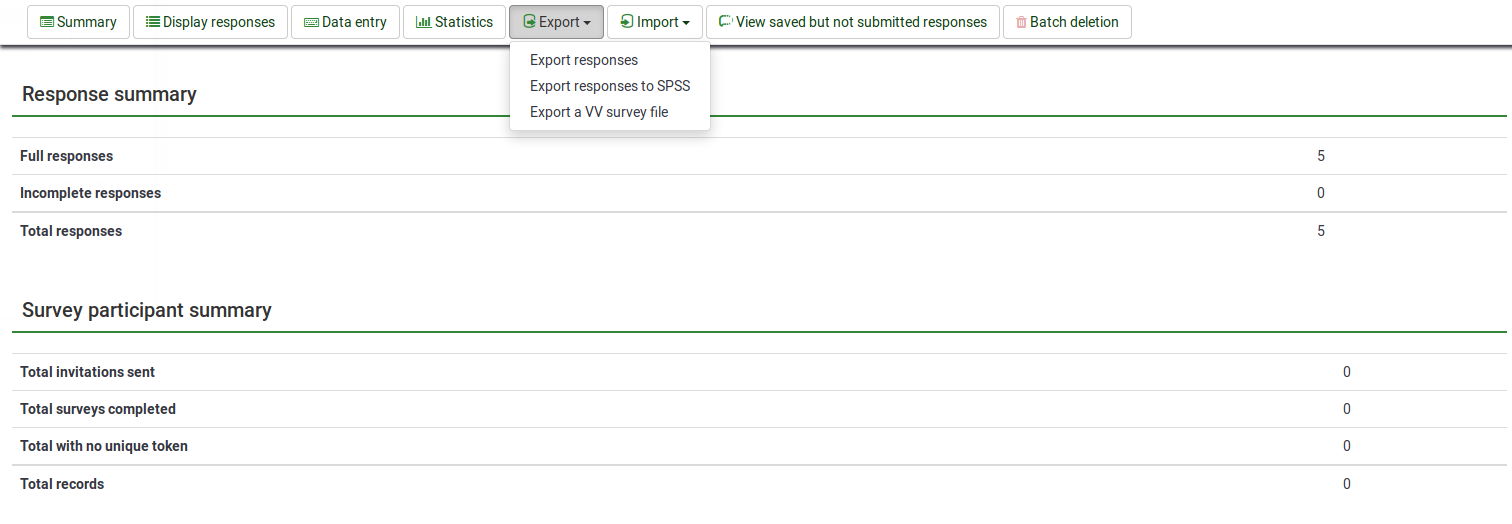
Na voljo je več možnosti:
Izvozi odgovore
Naslednja plošča se prikaže, ko je v spustnem meniju izbrana prva možnost, povezana z izvozom:
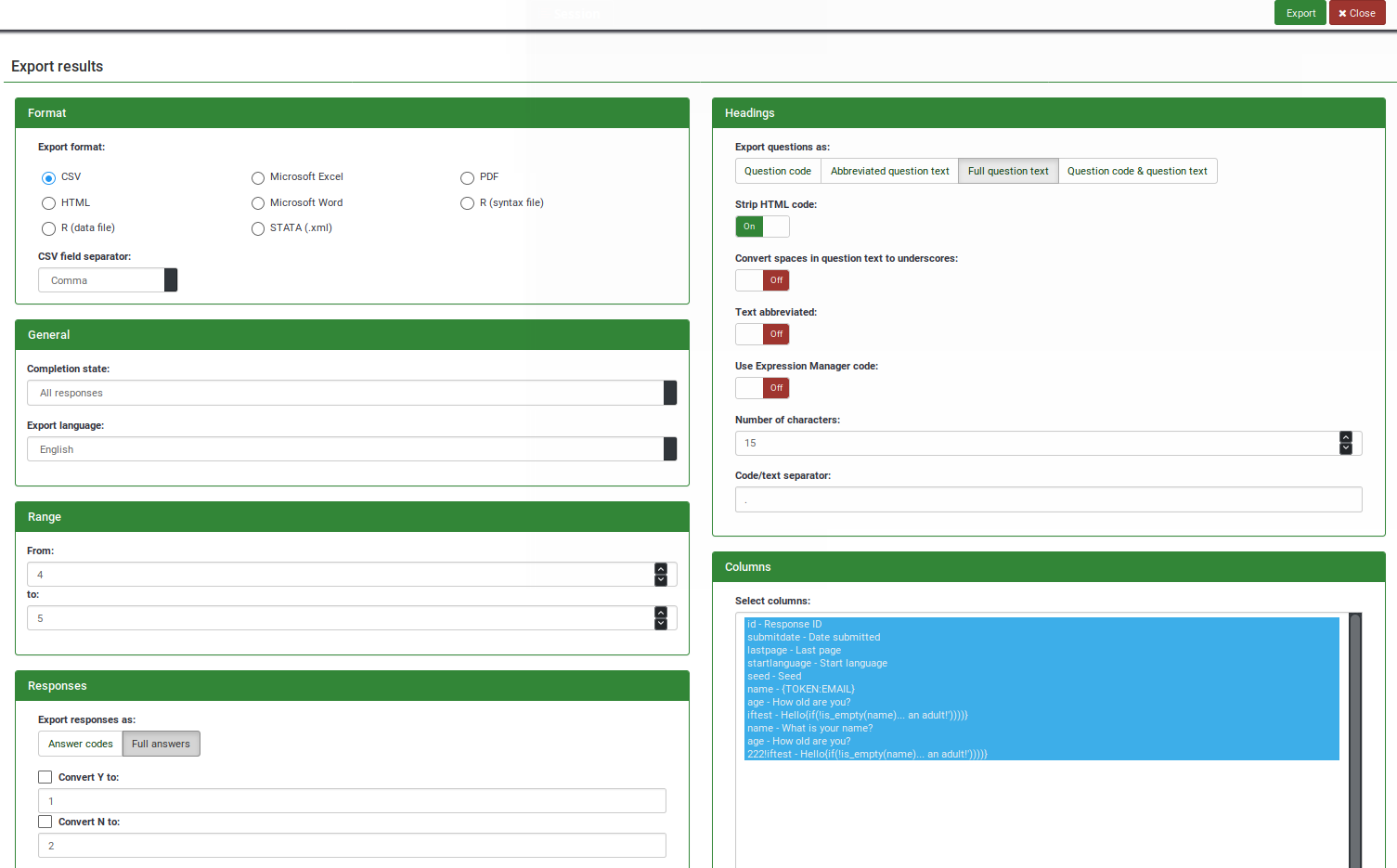
Več možnosti filtra je razdeljenih na:
- 'Oblika: vam omogoča, da izberete obliko, v kateri želite izvoziti svoje rezultate. Na voljo so naslednji formati:
- Datoteka CSV (vsi nabori znakov): glejte tudi možnost "Ločilo polj CSV" na dnu zavihka Oblika. Privzeta je "vejica". Drugi možnosti sta "podpičje" in "tabulator"
- HTML
- R (podatkovna datoteka): če je izbrana ta možnost, izvozite svojo anketo tudi v R ( sintaksna datoteka). Če želite izvedeti več podrobnosti o tem, kako lahko analizirate svoje podatke v R, preverite ta wiki podrazdelek
- Microsoft Word (latin charset)
- Microsoft Excel (vsi nabori znakov)
- STATA (.xml): za več podrobnosti o tem, kako analizirati svoje podatke v STATA, preberite naslednji wiki pododdelek
- R (sintaksna datoteka): če je izbrana ta možnost, izvozite svojo anketo tudi v R (sintaksna datoteka). Če želite izvedeti več podrobnosti o tem, kako lahko analizirate svoje podatke v R, preverite ta wiki podrazdelek
- 'Splošno'
- Stanje dokončanja: nastavljeno za izvoz vseh zapisov ALI samo dokončanih zapisov ALI samo nepopolnih zapisov. Za več informacij o njihovem pomenu preverite ta wiki pododdelek
- »Izvozni jezik:« privzeta možnost je osnovni jezik vaše ankete
- 'Razpon: nanaša se na ID shranjenih odgovorov iz tabele odzivov. Če so vrednosti, ki ste jih vnesli, napačne (tj. ID odgovora ni bil najden med vrednostmi, ki ste jih vnesli), se bo prikazalo pojavno okno, ko boste poskušali izvoziti odgovore, ki vas bodo pozvali, da vnesete vrednosti, ki jih najdete v tabela.
- ''Odzivi
- Izvozi odgovore kot: lahko izvozite celotne odgovore ali pretvorite kode odgovorov. Če izberete pozneje, bodo odgovori, ki so jih poslali vaši anketiranci, zamenjani s kodo odgovora zadevnega odgovora. Odgovora »Da« in »Ne« bosta pretvorjena v odgovora »Y« in »N« za kateri koli niz znakov. Če je omogočeno »Pretvori Y/N v«, bodo kode odgovorov, ki kot odgovora uporabljajo Y in N, pretvorjene v nize znakov iz ustreznih polj. Privzeto sta vrednosti 1 za Y in 2 za N.
- ''Naslovi
- Izvozi vprašanje kot: nastavi, kako naj izgleda naslov v izvoženi datoteki. Na voljo so naslednje možnosti:
- Koda vprašanja
- Skrajšano besedilo vprašanja: dolžina vprašanja se zmanjša, če izberete to možnost (uporabno, če delate z dolgimi vprašanji)
- *Celotno besedilo vprašanja (privzeto)
- Koda vprašanja in besedilo vprašanja
- Odstrani kodo HTML: je privzeto omogočeno, da se ne izvozi HTML, uporabljen v besedilnih poljih vprašanj
- Izvozi vprašanje kot: nastavi, kako naj izgleda naslov v izvoženi datoteki. Na voljo so naslednje možnosti:
- *»Pretvori presledke v besedilu vprašanja v podčrtaje:« je privzeto onemogočeno. Če je omogočeno, se presledki iz besedila vprašanja pretvorijo v podčrtaje.
- Besedilo skrajšano: je privzeto onemogočeno. Če je omogočeno, bo besedilo vprašanja skrajšano. Dolžina besedila vprašanja je podana s številko, vneseno v "Število znakov". Upoštevajte, da je ta možnost uporabna v primeru, ko želite skrajšati besedila vprašanj, ki izhajajo iz izbire bodisi »Celotno besedilo vprašanja« ali »Koda vprašanja in besedilo vprašanja« kot besedilo naslova.
- Uporabi kodo ExpressionScript : privzeto onemogočeno. Če je omogočeno, bodo vprašanja in podvprašanja izvožena, kot se uporabljajo v ExpressionScript. Zato bi bil naslov podoben poimenovanju spremenljivke qcode. Upoštevajte, da morate izbrati eno od naslednjih možnosti naslova vprašanja: "Koda vprašanja" ali "Koda vprašanja in besedilo vprašanja".
- Število znakov: nastavi največje število znakov, ki bodo prikazani v naslovih. Ta možnost deluje, če želite svoje vprašanje izvoziti kot skrajšano besedilo vprašanja. Privzeto število je 15.
- Ločilo koda/besedilo: izberite možnost, ki jo želite uporabiti za ločevanje kode vprašanja od besedila vprašanja. Privzeto je "pika", ki ji sledi prazen niz (<SPACE> ).
- 'Column Control': nastavi vprašanja (in njihove ustrezne odgovore), ki naj se izvozijo. Vprašanja na tem seznamu so predstavljena z ustrezno kodo vprašanja in besedilom vprašanja. Privzeto bodo izvoženi vsi stolpci. Če želite izbrati več stolpcev, uporabite tipki CTRL in/ali SHIFT.
- 'Nadzor žetonov - nastavi, kateri podatki o udeležencih ankete' naj se izvozijo. Ta možnost je na voljo le, če vaša anketa ni anonimna! Kliknite tukaj za več informacij o tem, kaj je tabela udeležencev ankete in kako jo lahko uporabite v LimeSurvey.
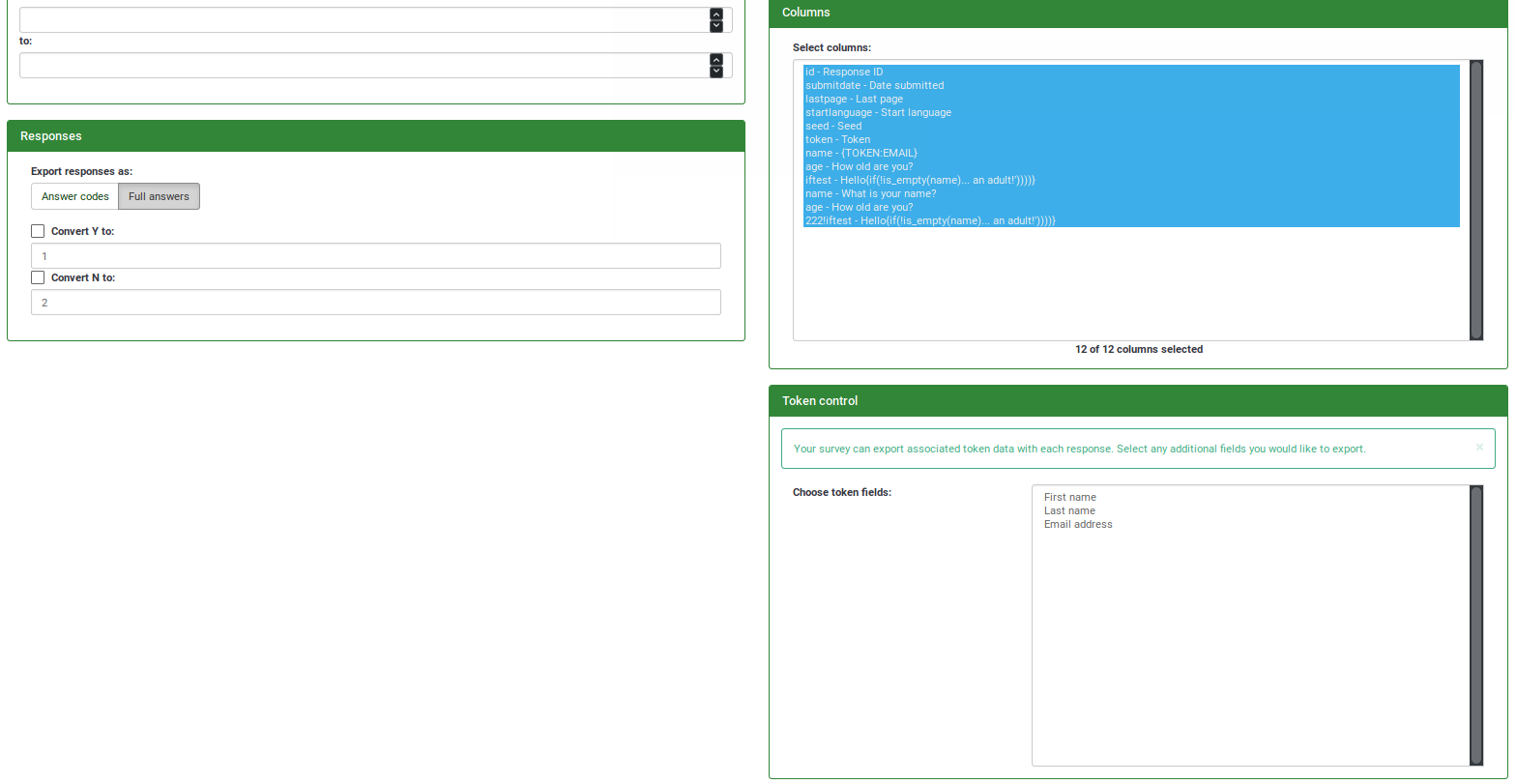
Izvoz R
Brezplačno programsko okolje R je alternativa za SPSS, ki se uporablja za statistično računalništvo in grafiko.
Sledite tem korakom za uvoz nabora podatkov v R:
- Prenesite obe datoteko s sintakso in podatkovno datoteko
- Shranite obe datoteki v svoj delovni imenik R (uporabite getwd() in setwd() v ukaznem oknu R za pridobite in nastavite svoj delovni imenik)
- Vnesite
source("File_name_syntax.R")v ukazno okno R. Podatke bo uvozil v pravilni obliki v podatkovni okvir, imenovan »podatki«.
Odgovori z omejenimi možnostmi bodo upoštevani z ravnmi, ki se ujemajo s kodo vprašanja, in oznakami, ki se ujemajo z možnostmi.
Vprašanja z možnostjo »drugo« bodo imela polje vprašanja z _Other dodano kot nov stolpec za druge podatke.

Izvoz Stata-xml
Stata je komercialni programski paket za analizo podatkov in statistiko.
This export routine was created to facilitate rapid analysis of data collected with LimeSurvey. It creates an XML-file in Stata's proprietary format. This format offers several advantages over importing plain CSV files:
- Data sets are fully labelled including variable labels (question, subquestion) and value labels (answers, if applicable).
- Dates are already transformed to Stata's internal date format and thus can directly be used to calculate differences between days etc.
- Variable names are, if necessary, converted to a Stata compatible format.
- Data formats of variables (string, integer, float, etc.) are already set according to the underlying data (no more numbers encoded as strings!).
How to load the file in Stata:
- In Stata's menu, click on File, Import, xml-data
- Choose browse to navigate to your exported file and click 'OK'.
- Due to a limitation in Stata's data format, the length of string (text) variables have a maximum of 244 characters (Stata versions 8-12) and 2045 characters (Stata version 13 and above). Please indicate your Stata version in the settings of the export plugin:


- Stata only supports attaching value labels to numerical values. So, to achieve short answers (usually one or two digits) and have these properly labelled, one should use numerical answer-codes in LimeSurvey (1=Totally agree). If non-numerical answer codes are used (A=Totally agree), then the complete answer text will be used as answer (eg., 'Totally agree').
Export responses to SPSS
SPSS Statistics is a software package used for logical batched and non-batched statistical analysis. You can use the official SPSS package or GNU PSPP replacement for the proprietary program SPSS.
To export your response data to SPSS, go to Responses & statistics section and select the SPSS-corresponding option located under the Export menu:

The following page is displayed:

The following options are displayed in the panel:
- Data selection: you can select which data should be selected for export: all responses OR only complete responses OR only incomplete responses
- SPSS version: Check your SPSS installation version. Three different export options can be chosen: "Prior to version 16 / PSPP", "16 or up" and "16 or up with Python Essentials"
- Language: acts like a filter that allows you to filter the exported responses based on the language used to fill out the survey
- Limit: type in any numerical value to get exported only the first "n" entries from your response table
- Offset: type in any numerical value to get exported your response table without the first "n" entries from your response table
- No answer: if left empty, an empty string is stored as answer for the questions that have not been answered by respondents. Type in this box any string of characters to replace the empty string. The set of characters will be displayed in the exported .dat file
SPSS export includes two files:
- a syntax file (survey_xxxx_SPSS_syntax_file.sps)
- and a data file (survey_xxxx_SPSS_data_file.dat).
After having downloaded these files you can open them using a raw text editor like notepad to take a look how the exported data looks like. The syntax file holds the commands that should be run to import the data. It is like a programming language inside SPSS. The .dat file contains a comma separated file with all data. We recommend you not to import your data as csv because there is the risk of loosing information about questions, label sets, and so on.
Import LimeSurvey responses to SPSS
To import your data to SPSS, pursue these steps:
- Download the data and the syntax file.
- Open the syntax file in SPSS in Unicode mode.
- Edit the 'FILE=' line and complete the filename with a full path to the downloaded data file.
- Choose 'Run/All' from the menu to run the import.
- Done
VVExport
Once you've begun collecting responses, there may be occasions where you need to be able to directly edit and modify large quantities of data from your responses table (where a spreadsheet tool may be more useful).
VVExport (the "VV" stands for vertical verification) allows you to export your responses table into a .csv file. So long as the general structure of the file remains intact, you can then edit values within it, and then import the file again into your responses table using the "VVImport" feature.
It is often used in three scenarios:
- In the first one, it is used to combine large amounts of data in one LimeSurvey installation. Imagine that you run two similar surveys on two different machines. In order to combine the two response tables, you will have to use VVExport, VVImport, and a third-party app (e.g., spreadsheet apps) to combine your data and put it on one LimeSurvey installation.
- It may also be used to edit the response table of a survey. For small edits, you can access the response table and edit the desired answers. Still, for "macro-editing", VVExport and VVImport are recommended because a spreadsheet program can help you quickly edit dozens of responses at the same time.
- A "vv survey file" allows you to import the responses to a survey when the question/answer combinations have changed. Effectively, this allows you to add or remove questions in an active survey.
To export your data via VVExport, go to Responses & statistics section and select the VV-corresponding option located under the Export menu:
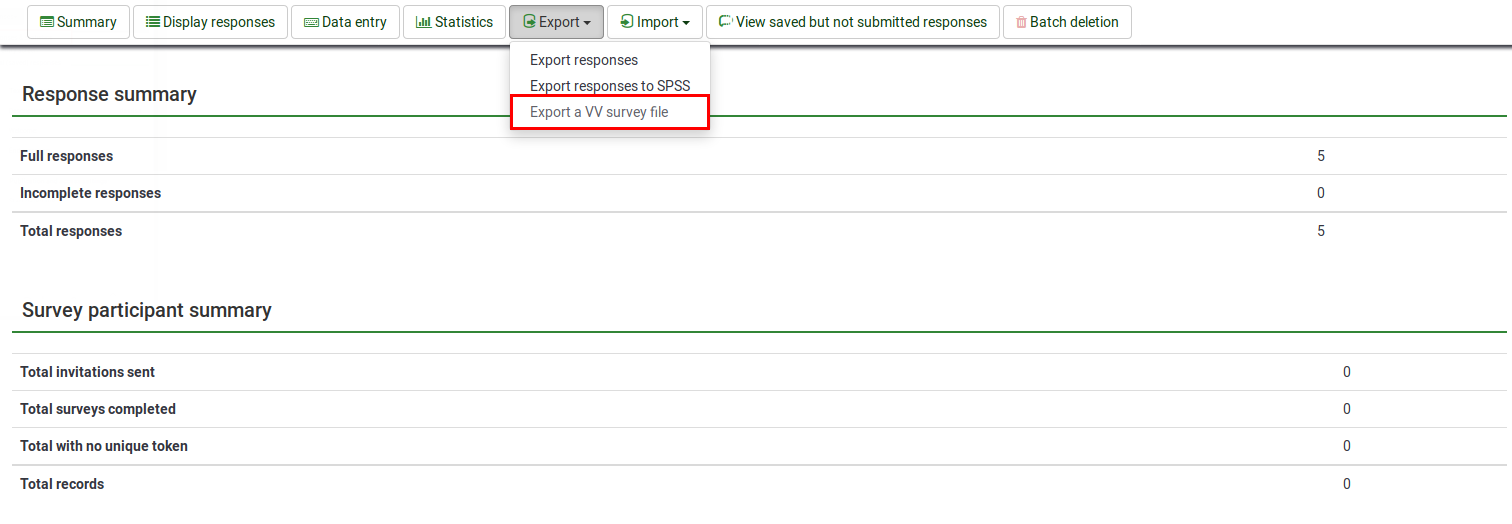
The following page will be loaded:

- Survey ID:: The ID of the survey to be exported
- Export: The completion state of the responses to be exported:
- Completed responses only: if a respondent reaches the last page of a survey and clicks the Submit button, then his or her response is marked as being complete
- Incomplete responses only: if a respondent does not click on that Submit button located before the end page, then the response is marked as being incomplete
- All responses: export both completed and incomplete responses
- File extension: The file extension. The file is a TSV (tab-separated values) file. For easy opening in MS-Excel set the extension to .txt. If you use LibreOffice, OpenOffice or any other spreadsheet program, you can leave it to .csv (default format)
- VV export version: The 1.0 version (Old VV version) uses database column headers, version 2.0 (Last VV version) uses Qcode Variable Naming. Version 2.0 is selected by default if all of your question code are unique.
- If you want to import responses using "VVImport" make sure to check whether the responses should be added to the existing responses or all responses should be overwritten.
- If you are trying to import responses from a different yet identical (e.g., identical questions/answers from another survey), make sure you are using the correct vv file and that the first two lines of the .csv file are correct.
- If you import a survey to your LimeSurvey installation the SID will not change (if possible). The group id and question id however might change. So you might have to adjust the first two heading lines to match the new group id/question id.
Exporting a VV survey file
When you choose to export responses using VVExport, you will be given the option to choose whether you want to export all responses or complete responses only or incomplete responses only. The file extension allows you to choose which extension the exported file will have. For easy use, .csv should be chosen.
The first two rows of the spreadsheet/tab-delimited file are the column labels. The first row is a "human readable" column heading that details the name of the question/answer field. The second row is the internal PHP/database column name for that response.
You should not modify the first two rows of this spreadsheet if you want to be able to "import" the data back into LimeSurvey at a later point.
VV files structure - example
VV version 1 TSV file
Response ID Date submitted Last page Start language Token please vote from 1 to 6 (1 - super, 6 - worst)
id submitdate lastpage startlanguage token 46492X40X1991
183 09.11.11 11:44 3 de jsfhusdgqfygqsy 4
184 09.11.11 11:53 3 de sdfhsifgsyergze 2
190 09.11.11 11:44 3 de qsdqshkfhkdsjhj 1
VV version 2 TSV file
Response ID Date submitted Last page Start language Token please vote from 1 to 6 (1 - super, 6 - worst)
id submitdate lastpage startlanguage token QCODE
183 09.11.11 11:44 3 de jsfhusdgqfygqsy 4
184 09.11.11 11:53 3 de sdfhsifgsyergze 2
190 09.11.11 11:44 3 de qsdqshkfhkdsjhj 1
In this example, the SQGA identifiers are not used - instead, the Qcode variable naming QCODE is used in the second line.
We generally recommend our users to use question codes since they are much easier to be used (it represents an addition to the SGQA system used in the earlier versions of LimeSurvey.
Reserved names
A .vv file uses left and right brackets for reserved names. When importing, this string is replaced by:
{question_not_shown}: NULL value in database. LimeSurvey uses [empty string] for not answered question, and NULL value for questions not shown.{quote}: " (a double quote){cr}: Carriage return{newline}: A new line{lbrace}: Left bracket (for example, if you want to have {cr} in response : use{lbrace}{cr})
Editing a VV survey file
When a .vv file has been successfully exported you can use a spreadsheet tool to open and edit the file. If you have to choose a column separator when opening the file please use the "Tab" character. If you are using non-ASCII characters make sure you set "UTF-8" as character set.
If you simply wish to simply edit your data, then be careful at the first two columns so that you can later easily VVImport your data back into your LimeSurvey installation!
If you combine data from two different surveys, please note that the old VV version uses SGQA which will most probably give you different "question ids". Therefore, be careful how you merge the data!
The alternative would be to use the last VV version because question codes can be constant throughout different LimeSurvey installations (if you use the same survey structure across multiple LimeSurvey instances).
When importing the VV file, if two response IDs match and the Exclude record IDs is disabled, you can make LimeSurvey:
- Report and skip the new record
- Renumber the new record
- Replace the existing record
- Replace answers in file in the existing record
Other export options
In case you do not need to export the whole survey, you can also choose to export only:
Export a single response
If you want to export an individual response, you can do it in two ways:
1. Login to LimeSurvey, choose your survey, click on Notifications & data tab and make sure you receive basic email notifications:
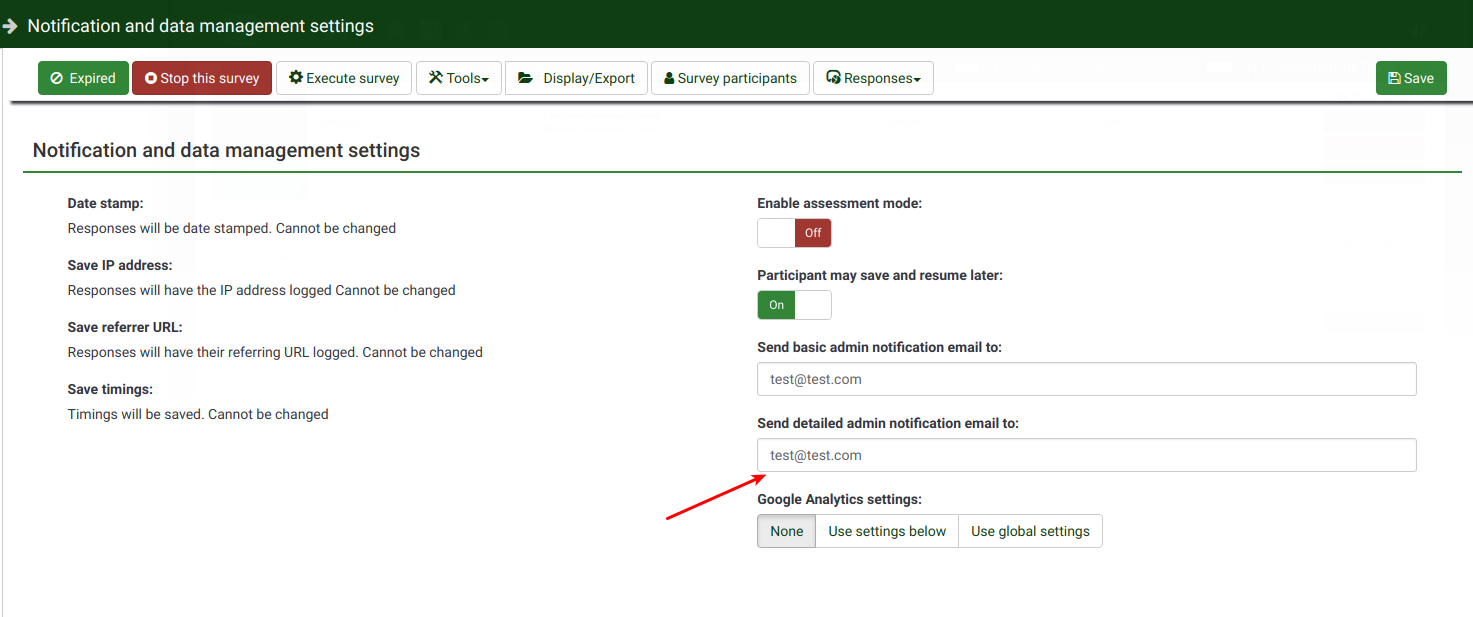
Every time someone has completed a survey, you will receive an email with a link: "Click the following link to see the individual response". This will take you to a page with a button above the response data saying "Export this response":

Choose how the single response will be exported:
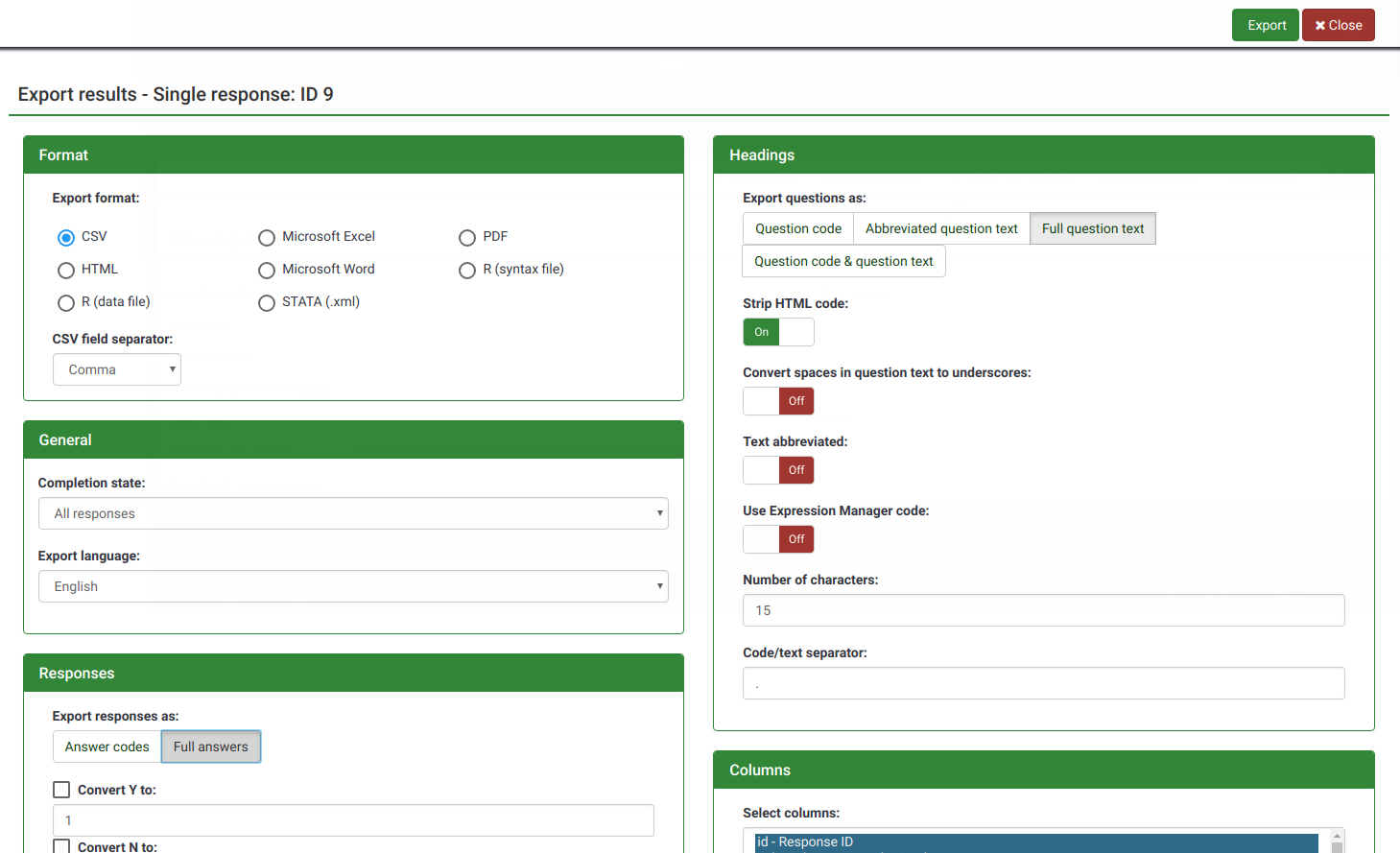
2. Login to your LimeSurvey installation/instance, choose your survey. Select tab Responses located under the settings tab:

See the "action" column. Hover the mouse over each option and see which one allows you to see the response details (the first button):
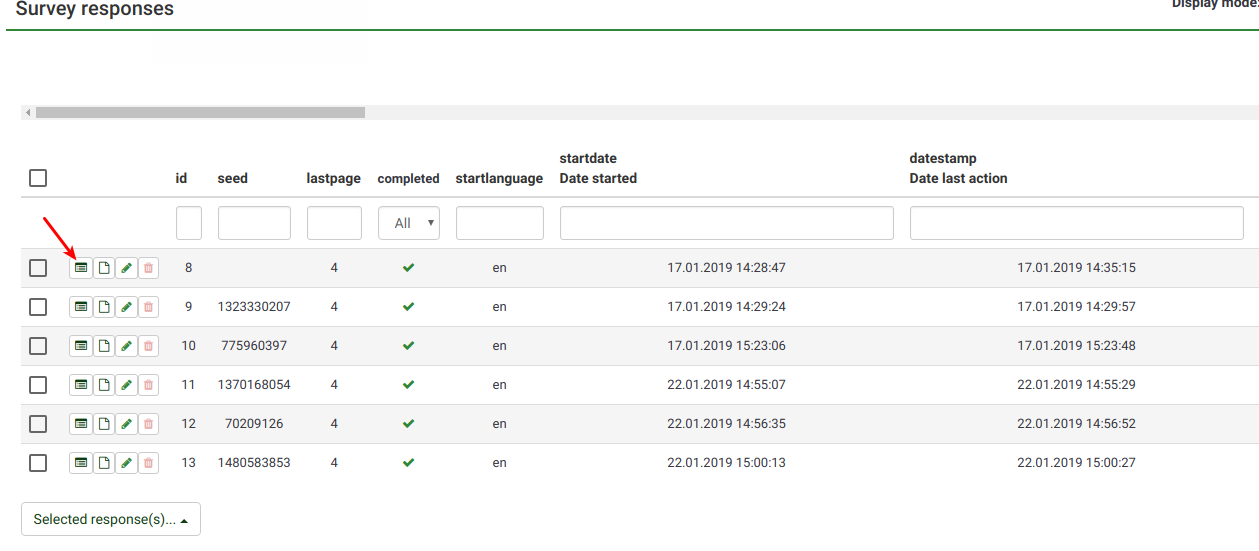
The response entry will be loaded. Click on the "Export this response" button. You will be redirected to a panel from where you can select how the exported file should look like:

As you can observe, you can also export the response as a pdf file:

This option is usually needed when you wish to share to one of your respondents his/her results. In the case in which you wish to share only certain parts of his/her answer, check the pdf export option located in the Statistics panel. In this way, you can hide your hidden questions and/or different assessments you run "in the background".
Export a group of responses
This option is useful in the case in which you wish to export a certain group of filtered responses.
To do it, access your Responses table table:

You can either order the responses according to the value from each column by clicking on the column label or you can type in the empty boxes located below the column labels a string of characters according to which you wish your data to be filtered to.

Once done, your table should look like the one below. Now, tick all the filtered responses, click on the Selected response(s)... button located in the bottom left side of the response table, and select the Export button:
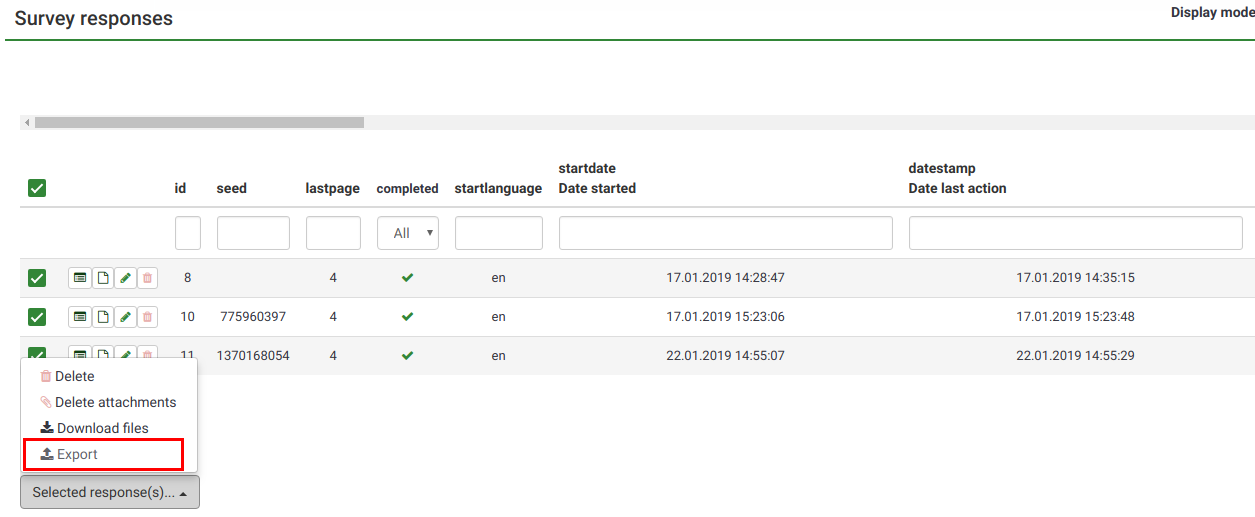
The next page will be loaded:
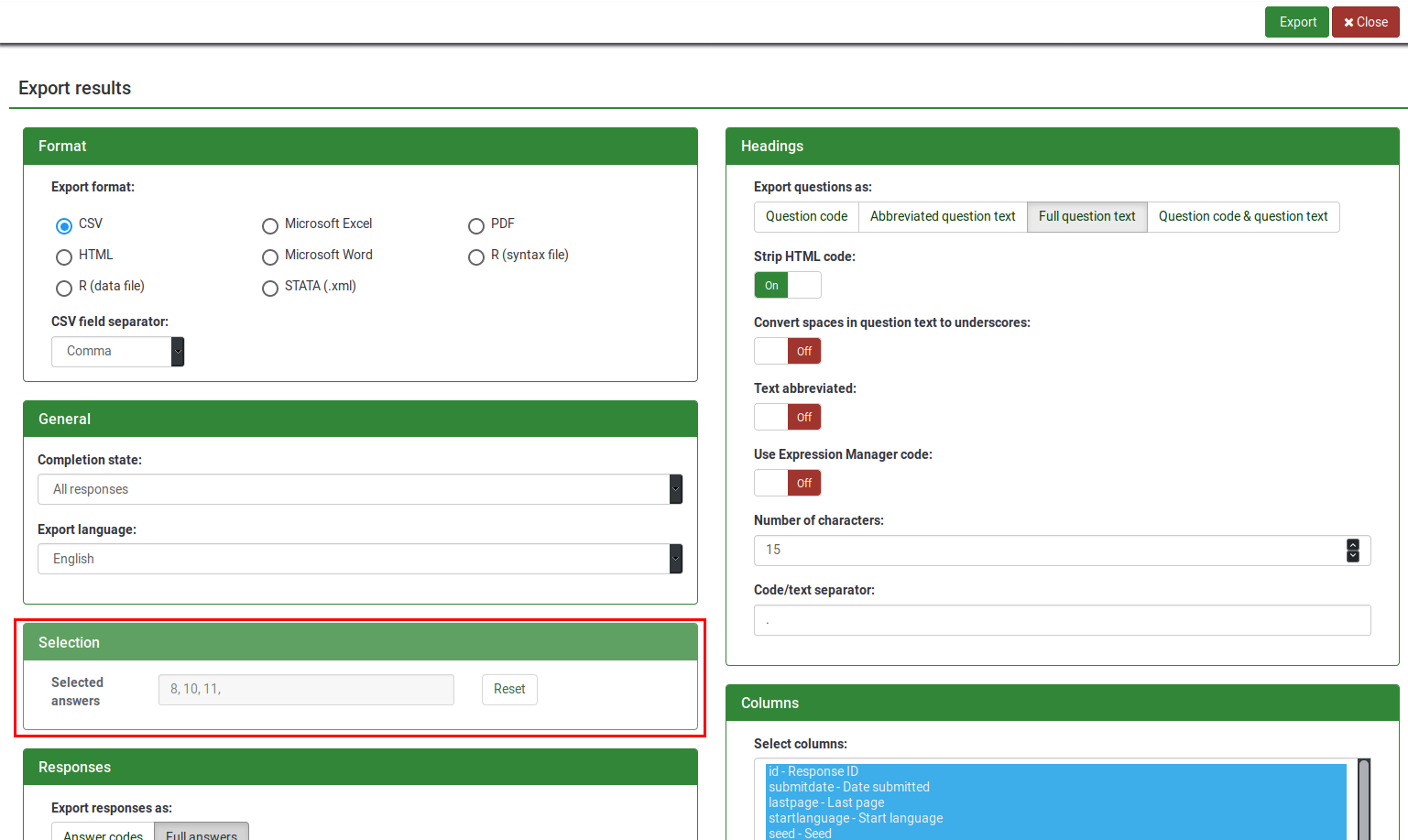
The Range column is not displayed since you have already selected the entries you wish to export. To check those IDs, check Selection (see the above screenshot). You can click on Reset if you wish to export all your data instead.